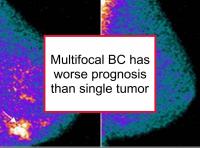Multifocal and multicentric breast cancer both involve more than one invasive tumor in a single breast. In multifocal breast cancer, there are two or more tumors within the same quadrant of the breast. In multicentric breast cancer, there are two or more invasive tumors within different quadrants of the same breast.
Lobular breast cancer and HER2 overexpressing (HER2+) breast cancer are more likely to be multifocal than other types of breast cancer. Although this news article refers to multifocal breast cancer, the findings can also be applied to multicentric breast cancer.
Multifocal breast cancer is associated with lower survival
A number of studies have reported that multifocal breast cancer is associated with increased local (in the breast) and distant recurrence and reduced survival compared to similar unifocal (breast cancer with only one tumor) disease. For example, one study of 574 women with breast cancer reported that the 10-year breast cancer-specific survival was 90% for those with unifocal invasive disease compared to 76% for those with multifocal invasive disease.
Invasive multifocal breast cancer has aggressive qualities that are not completely accounted for by traditional prognostic markers. For example, multifocal ER+/PR+ breast cancer is more likely to have lymph vessel invasion and lymph node metastasis than similar unifocal breast cancer. The likelihood of lymph vessel invasion and lymph node metastasis are known to increase gradually with tumor size, however they are elevated in multifocal tumors in every size category. The higher the number of tumors, the worse the outlook. However, note that the risk of positive lymph nodes is not elevated in unifocal invasive breast cancer with a multifocal DCIS component.
Breast conserving surgery for multifocal breast cancer
Although breast conserving treatment (typically, lumpectomy plus radiotherapy) is commonly used for multifocal breast cancer, it is apparent that it is not ideal for all such cases. Can a surgical team really be sure that all the tumor tissue has been removed in a case of multifocal lobular breast cancer in which only one tumor was initially detected by mammogram or breast MRI? Radiation treatment is designed to kill any remaining cancer cells in the breast after surgery; it is not sufficient to kill all the cells in a residual invasive tumor. Therefore, it is important that all tumors be removed during surgery. Several studies have been conducted to determine whether breast conserving therapy is as effective as mastectomy for women with multifocal breast cancer. However, the studies have not made much progress in identifying which women should have a mastectomy.
According to available evidence, breast conserving treatment appears to be safe for small, early stage multifocal tumors (largest tumor under 1 cm) without an extensive DCIS or LCIS component. Wide clear surgical margins should be achieved and should not contain any DCIS or LCIS. This is not to say that lumpectomy is not safe in other circumstances, but studies are lacking to define those circumstances.
Latest research finds worse survival for multifocal breast cancer
The study referenced at the beginning of this news article was designed to compare survival outcomes of multifocal and unifocal breast cancer patients who underwent breast conserving therapy. To conduct the study, the authors used prospective data concerning women with invasive breast cancer who were treated with lumpectomy or partial mastectomy plus whole breast irradiation between 1991 and 2009.
Multifocal breast cancer was defined as two or more distinct tumors removed in a single operation. The study included 164 patients with multifocal and 999 with unifocal invasive breast cancer who were followed for a median of 112 months. The women with multifocal disease were compared to those with unifocal breast cancer with respect to demographics, tumor characteristics, systemic treatment after surgery, local recurrence, disease-free survival, and overall survival.
Women in the multifocal breast cancer group had higher 10-year rates of local recurrence (6.1%) compared with the unifocal group (0.6%). Similarly, women in the multifocal group had lower 10-year breast cancer-free survival (89.3% compared to 97.7%) and overall survival (85.8% compared to 98.4%) rates. The authors conclude that breast conserving therapy in multifocal breast cancer is oncologically safe but might result in slightly inferior outcome compared with breast conserving therapy in unifocal breast cancer.
